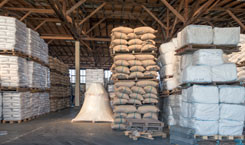Transporting Coffee - The big Journey
Every single coffee beans is leaving many thousand kilometers behind while traveling from its field all the way into your latte macchiato cup. Involved are almost all methods of transport, humankind invented so far and its sheer mass makes coffee one of the most important world trade goods of the 21st century.
Both manually and mechanically harvested beans usually start their very first journey by being loading into a small trailer behind small and agile, mostly antique looking little tractors. Only in extremely steep and impassible areas, this step is skipped and the pickers take their coffee bags directly to the farmhouse.
After the processing, drying and filtering, the raw coffee is assorted into different qualities and beans sizes. They are packed into gunnysacks of up to 60 kg (70 kg in Latin America) and loaded into trucks. The trucks either take their precious cargo to the next inland port or to the big coffee ports like Santos in Brazil. There, the gunnysacks are being stored for up to several months before being loaded on the major cargo ships inside of standard shipping containers. After two to three weeks the coffee will arrive in ports all over the world, for example Germanys largest coffee port, Hamburg to be loaded on trucks, trains and smaller ships once again.
It is of greater importance, that the coffee is protected from moisture during the transport. Ideally, coffee is being stored and transported at a core temperature of 18-25 °C. Through bigger changes in temperature, condensing water will accumulate on the containers walls, also called „container sweat“. The moisture can cause the coffee to alter its aromas at best or to rot and become a danger for the consumers' health at worst. Therefor chipping containers containing coffee should be shelved as far inside the ship as possible and especially during unloading in colder harbors like hamburg, coffee containers should not be left exposed to the cold air for too long.
Finally, the coffee is roasted in many different ways in one of Germanys over 300 roasting companies and subsequently packed in small packages as a whole bean or ground coffee. The roasting companies then load their coffee on trucks for the last time, to deliver them to the supermarkets and coffee shops. A big portion of the 1,4 million tonnes of coffee, Germany is annually importing, is being used to create other coffee products like instant coffee and coffee without caffeine. Germany is the largest exporting country for processed coffee products.
Dying of the gunnysacks
Mainly to save money, the traditional and iconic coffee gunnysacks are being used less and less. Large corporations and cooperatives tend to ship their precious coffee almost exclusively as bulk good in specially designed bulk carriers for inland rivers and in bulk good shipping containers. Today, about 95% of the coffee is being shipped as bulk good in shipping containers.

